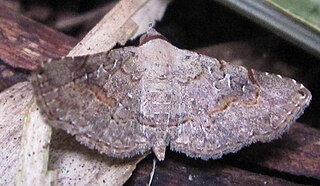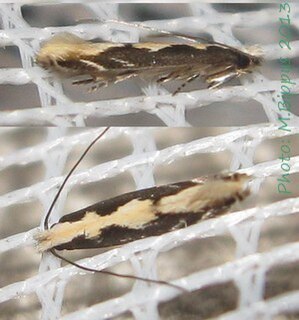
Batrachedra is the largest genus in the moth family Batrachedridae, with representatives all over the world. The early stages of most species are unknown. The genus name is derived from the Greek words batrachos, 'frog', and edra, 'seat', referring to the frog-like resting posture of the adult moths. As of 2018 at least some 114 species are known to belong to the genus.

The Lecithoceridae, or long-horned moths, are a family of small moths described by Simon Le Marchand in 1947. Although lecithocerids are found throughout the world, the great majority are found in the Indomalayan realm and the southern part of the Palaearctic realm.

Dactylethrella is a genus of moths in the family Gelechiidae. The genus was described by Thomas Bainbrigge Fletcher in 1940 and is a replacement name for Dactylethra Meyrick (preoccupied).

Eublemma is a genus of moths of the family Erebidae described by Jacob Hübner in 1829.

Ozarba is a genus of moths of the family Noctuidae. The genus was erected by Francis Walker in 1865.

Rhesala is a genus of moths of the family Erebidae. The genus was erected by Francis Walker in 1858.

Amphixystis is a genus of moths belonging to the family Tineidae. The family was first described by Edward Meyrick in 1901.
Ocnophilella is a monotypic moth genus belonging to the family Tineidae described by Thomas Bainbrigge Fletcher in 1940. Its only species, Ocnophilella autocrypta, described by Edward Meyrick in 1926, was found in Western Cape, South Africa.

Lyonetia is a genus of moths in the family Lyonetiidae.
Sufetula minimalis is a moth of the family Crambidae. It was described by Thomas Bainbrigge Fletcher in 1911 and is found in the Chagos Archipelago and the Seychelles, both in the Indian Ocean.
Bipunctiphorus dimorpha is a moth of the family Pterophoridae. The species was first described by Thomas Bainbrigge Fletcher in 1910. It is known from the Seychelles, Sierra Leone, South Africa, Kenya, Réunion, Madagascar and Tanzania. It has also been recorded from China.
Oxyptilus erythrodactylus is a moth of the family Pterophoridae that was described by Thomas Bainbrigge Fletcher in 1911. It is known from South Africa.
Microschismus antennatus is a species of moth of the family Alucitidae. It was described by Thomas Bainbrigge Fletcher in 1909 and is known from South Africa.
Trichocirca is a monotypic moth genus in the family Choreutidae described by Edward Meyrick in 1920. Its only species, Trichocirca tyrota, described in the same publication, is known from Kenya.

Indarbela is a genus of moths in the family Metarbelidae described by Thomas Bainbrigge Fletcher in 1922.
Zebronia mahensis is a moth in the family Crambidae. It was described by Thomas Bainbrigge Fletcher in 1910. It is found on the Seychelles, where it has been recorded from Mahé and Silhouette.
Cophomantella alphanozoma is a moth in the family Lecithoceridae. It was described by Edward Meyrick in 1926. It is known from Sierra Leone and Uganda.
Cophomantella syngonarcha is a moth in the family Lecithoceridae. It was described by Edward Meyrick in 1926. It is known from Uganda.








